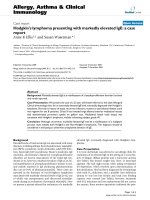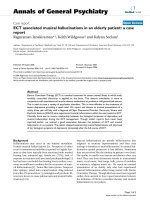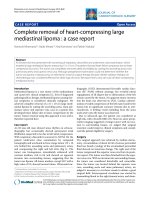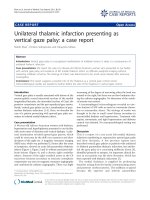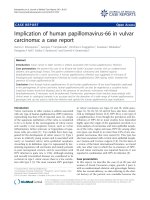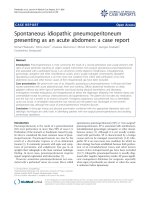Báo cáo y học: "Hodgkin''''s lymphoma presenting with markedly elevated IgE: a case report" potx
Bạn đang xem bản rút gọn của tài liệu. Xem và tải ngay bản đầy đủ của tài liệu tại đây (313.16 KB, 4 trang )
BioMed Central
Page 1 of 4
(page number not for citation purposes)
Allergy, Asthma & Clinical
Immunology
Open Access
Case report
Hodgkin's lymphoma presenting with markedly elevated IgE: a case
report
Anne K Ellis
1,2
and Susan Waserman*
1
Address:
1
Division of Clinical Immunology & Allergy, Department of Medicine, McMaster University, Hamilton, ON, Canada and
2
Division of
Allergy & Immunology, Department of Medicine, Queen's University, Kingston, ON, Canada
Email: Anne K Ellis - ; Susan Waserman* -
* Corresponding author
Abstract
Background: Markedly elevated IgE as a manifestation of a lymphoproliferative disorder has been
only rarely reported.
Case Presentation: We present the case of a 22 year old female referred to the adult Allergy &
Clinical Immunology clinic for an extremely elevated IgE level, eventually diagnosed with Hodgkin's
lymphoma. She had no history of atopy, recurrent infections, eczema or periodontal disease; stool
was negative for ova & parasites. Chest X-ray revealed large bilateral anterior mediastinal masses
that demonstrated prominent uptake on gallium scan. Mediastinal lymph node biopsy was
consistent with Hodgkin's lymphoma, nodular sclerosing subtype, grade I/II.
Conclusion: Although uncommon, markedly elevated IgE may be a manifestation of a malignant
process, most notably both Hodgkin's and Non-Hodgkin's lymphomas. This diagnosis should be
considered in evaluating an otherwise unexplained elevation of IgE.
Background
Elevated levels of total serum IgE are associated with many
diseases, including allergic bronchopulmonary aspergillo-
sis (ABPA), parasitosis, atopic dermatitis, adult HIV infec-
tion, hyper-IgE (Job's) syndrome, Sézary's syndrome, IgE
myeloma, and Kimura's disease[1]. Lymphoproliferative
disorders are known associations of the hyper-IgE syn-
drome [2-4], however a marked elevation of IgE as an ini-
tial manifestation of a lymphoproliferative disease is rare,
and mainly reported in IgE producing plasmacytomas;
also rare (0.01% of plasmacytomas)[5]. Three cases are
reported in the literature of non-Hodgkin's lymphoma
associated with markedly elevated levels of IgE [6-8], one
of which was asymptomatic and discovered serendipi-
tously during an evaluation of perennial rhinitis[6]. Here
we present a patient referred for evaluation of a markedly
elevated IgE, eventually diagnosed with Hodgkin's lym-
phoma.
Case Presentation
A 22 year old female was referred to our allergy clinic for
evaluation of an elevated IgE in the setting of a 4 year his-
tory of fatigue; diffuse pruritus and a microcytic anemia
(see Table). She denied weight loss, fever, or decreased
appetite. She had night sweats while taking venlafaxine
for depression, which resolved upon discontinuation of
this medication. She had been diagnosed by Hematology
with both B
12
deficiency and a possible iron deficiency
(serum Fe was low but ferritin and total iron binding
capacity were normal (see Table); however, treatment
with B12 injections and iron replacement did not correct
the anemia. Bone marrow aspiration confirmed the pres-
Published: 7 December 2009
Allergy, Asthma & Clinical Immunology 2009, 5:12 doi:10.1186/1710-1492-5-12
Received: 27 October 2009
Accepted: 7 December 2009
This article is available from: />© 2009 Ellis and Waserman; licensee BioMed Central Ltd.
This is an Open Access article distributed under the terms of the Creative Commons Attribution License ( />),
which permits unrestricted use, distribution, and reproduction in any medium, provided the original work is properly cited.
Allergy, Asthma & Clinical Immunology 2009, 5:12 />Page 2 of 4
(page number not for citation purposes)
ence of iron stores. There was associated thrombocytosis
(platelet count 592 × 10
9
/L, reticulocytosis (retic count
100 × 10
9
/L), elevated C-reactive protein (146.0 mg/L)
and an ESR of 50 mm/hr. Quantitative immunoglobulins
demonstrated an IgE level of 22,562 kU/L, prompting the
referral to Allergy & Immunology. Details of her investiga-
tions are summarized in Table 1.
She had no history of recurrent infections, eczema or per-
iodontal disease, nor was there a history of foreign travel,
diarrhea or other symptoms suggestive of parasitic infec-
tion. There was no history of allergic rhinitis (seasonal or
perennial), asthma, sinusitis, otitis or other allergic dis-
ease. Her physical examination was entirely normal. Skin
tests were positive to trees, grass and ragweed, and careful
questioning confirmed an absence of clinical symptoms
aside from intermittent cough. Stool examination was
negative for ova & parasites. Spirometry and metha-
choline challenge revealed a mild isolated decrease in dif-
fusion capacity, and no airway hyper-responsiveness.
After initial investigations were completed, her symp-
tomatology remained unexplained. Investigation was
extended with repeat stool examination, and a chest x-ray,
which revealed large bilateral anterior mediastinal masses
(see Figure 1). Further evaluation with gallium scan dem-
onstrated prominent diffuse uptake within these lesions,
and a CT of the chest & abdomen confirmed the presence
of multiple enlarged anterior mediastinal lymph nodes
and mild hepatomegaly. A mediastinal lymph node
biopsy was consistent with Hodgkin's lymphoma, nodu-
lar sclerosing subtype, grade I/II. She was reassessed by
Hematology and treatment with ABVD (adriamycin, ble-
omycin, vinblastine and dacarbazine) was initiated.
Table 1: Laboratory parameters upon referral to Allergy & Immunology Clinic.
Parameter Value Reference (Units) Parameter Value Reference (Units)
Creatinine 64 50-100 umol/L WBC 10.2 4.0-11.0 ×10^9/L
Urea 2.3 3.0-6.5 umol/L Eosinophils 0.1 0.0-0.4 ×10^9/L
Sodium 140 135-145 mmol/L Hb 103 115-165 g/L
Potassium 3.7 3.5-5.0 mmol/L MCV 76.7 82-99 fL
Chloride 104 98-107 mmol/L Platelet 592 150-400 ×10^9/L
Total Protein 81 60-80 g/L Retic 100 10-86 ×10^9/L
Albumin 33 35-50 g/L ESR 50 1-20 mm/hr
A/G ratio 0.7 1.4-1.6 CRP 122 <3.0 mg/L
AST 14 <35 U/L C3 1.67 0.73-1.73 g/L
ALT 22 <28 U/L C4 0.3 0.13-0.52 g/L
GGT 65 <32 U/L IgA 1.6 0.70-3.52 g/L
Alk Phos 293 40-120 U/L IgD 4 <140 mg/L
Bilirubin 5 2-18 umol/L IgE 18 429 <120 kU/L
Ferritin 173 51-400 ug/L IgG 13.9 6.35-14.65 g/L
CK 27 <150 U/L IgM 1.07 0.41-2.07 g/L
LDH 308 100-220 U/L RF <11.0 0-15.0 IU/mL
TIBC 43 4-80 umol/L
Fe 4 9-30 umol/L
Allergy, Asthma & Clinical Immunology 2009, 5:12 />Page 3 of 4
(page number not for citation purposes)
Ongoing treatment with ABVD has resulted in a partial
response based on PET scan FDG (F-18 fluorodeoxyglu-
cose) uptake; IgE has decreased to 4,014 kU/L.
Discussion
Significant elevations of IgE are seen in various allergic
conditions, parasitosis, and rarely, in lymphoproliferative
malignancies. Specifically, extreme elevations of IgE have
been documented in the setting of multiple myeloma,
and B-cell lymphomas. In this case, the patient had no
history of atopy, or parasitic infection and she had a nor-
mal protein electrophoresis and bone marrow evaluation.
Lymphomas are known to produce immunoglobulins,
and rarely, cases have been reported of both B- and T-cell
lymphomas associated with elevated IgE [6-8]. Sézary's
syndrome (a peripheral T-cell neoplasm) has been associ-
ated with elevated IgE and/or eosinophilia when the
malignant clone is of the CD4+ helper phenotype and
produces an abnormal amount of the cytokine IL-4[9,10].
Modestly elevated IgE has also been reported in B-cell
chronic lymphocytic leukemia[11] and in 2 patients with
Hodgkin's disease (1 case of nodular sclerosing, one case
of mixed cellularity, levels were 675 IU/mL and 310 IU/
mL, respectively)[12].
Conclusion
Markedly elevated IgE may rarely present as an initial
manifestation of a lymphoproliferative disorder such as a
lymphoma. These patients may be referred for evaluation
of allergy or immunodeficiency, such as hyperIgE syn-
drome. This patient had unexplained fatigue and anemia,
and only chest X-ray was suggestive of a malignant proc-
ess. Underlying lymphoproliferative disease should
always be considered when evaluating an otherwise unex-
plained significant elevation of IgE, particularly when fea-
tures of allergy or parasitosis are distinctly lacking.
Specific work-up of significantly elevated IgE levels should
be tailored to the clinical features of the case, but in this
circumstance a serum LDH and a CXR helped to reveal the
underlying causative lymphoma.
Consent
Written informed consent was obtained from the patient
for publication of this case report and accompanying
images. A copy of the written consent is available for
review by the Editor-in-Chief of this journal.
Comepeting interests
The authors declare that they have no competing interests.
Authors' contributions
AKE and SW both saw this patient in an outpatient
Allergy/Immunology clinic. AKE wrote the first draft of
the manuscript and SW and AKE jointly worked on several
subsequent revisions to the manuscript. Both AKE and SW
contributed to the comments raised upon peer review and
the final revised, accepted version of the manuscript. Both
authors have read and approved the final manuscript.
Acknowledgements
No external funding was received to support this publication.
Chest x-ray, PA and Lateral viewsFigure 1
Chest x-ray, PA and Lateral views.
Publish with BioMed Central and every
scientist can read your work free of charge
"BioMed Central will be the most significant development for
disseminating the results of biomedical research in our lifetime."
Sir Paul Nurse, Cancer Research UK
Your research papers will be:
available free of charge to the entire biomedical community
peer reviewed and published immediately upon acceptance
cited in PubMed and archived on PubMed Central
yours — you keep the copyright
Submit your manuscript here:
/>BioMedcentral
Allergy, Asthma & Clinical Immunology 2009, 5:12 />Page 4 of 4
(page number not for citation purposes)
References
1. Ownby D: Clinical significance of IgE. In Allergy principles and prac-
tice Edited by: Adkinson NF Jr, Bochner BS, Busse WW, Holgate SJ,
Lemankse RF Jr. Mosy Year book, Inc, St Louis; 2003:1087-1101.
2. Gorin LJ, Jeha SC, Sullivan MP: Burkitt's lymphoma developing in
a 7-year-old boy with hyper-IgE syndrome. J Allergy Clin Immunol
1989, 83:5-10.
3. Leonard GD, Posadas E, Herrmann P: Non-Hodgkin's lymphoma
in Job's syndrome: a case report and review of the literature.
Leuk Lymphoma 2004, 45:2521-2525.
4. Lin SJ, Huang JL, Hsieh KH: Hodgkin's disease in a child with
hyperimmunoglobulin E syndrome. Pediatr Hematol Oncl 1998,
15:451-454.
5. Jako JM, Gesztesi T, Kaszas I: IgE Iambda monoclonal gammop-
athy and amyloidosis. Int Arch Allergy Immunol 1997, 112:415-421.
6. Young MC, Harfi H, Sabbah R: A human T cell lymphoma secret-
ing an immunoglobulin E specific helper function. J Clin Invest
1985, 75:1977-1982.
7. Miyake S, Yoshizawa Y, Ohkouchi Y: Non-Hodgkin's lymphoma
with pulmonary infiltrates mimicking miliary tuberculosis.
Intern Med 1997, 36:420-423.
8. Koutsonikolis A, Day N, Chamizo W: Asymptomatic lymphoma
associated with elevation of immunoglbulin E. Ann Allergy
Asthma Immunol 1997, 78:27-28.
9. Borish L, Dishuck J, Cox L: Sezary syndrome with elevated
serum IgE and hypereosinophilia: role of dysregulated
cytokine production. J Allergy Clin Immunol 1993, 92:131.
10. Spinozzi F, Cernetti C, Gerli R: Sezary's syndrome: a case with
blood T-lymphocytes of helper phenotype, elevated IgE lev-
els and circulating immune complexes. Int Arch Allergy Appl
Immunol 1985, 76:282-285.
11. Neuber K, Berg-Drewniock B, Volkenandt M: B-cell chronic lym-
phocytic leukemia associated with high serum IgE levels and
pruriginous skin lesions:successful therapy with IFN-α 2b
after failure on IFN-γ. Dermatology 1996, 192:110-115.
12. Samoszuk M: Reed-Sternberg cells of Hodgkin's disease with
eosinophilia. Blood 1992, 79:1518-1522.
